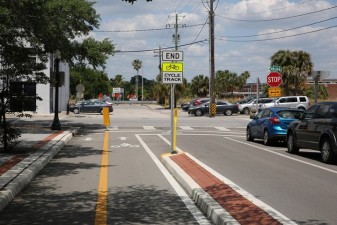436656-1 New York Avenue Pedestrian Crossing Design
Project Details
About
Welcome to the website for the New York Avenue Pedestrian Crossing Design in Polk County. From May 2015 through April 2019, a Project Development and Environment (PD&E) study was completed to study bicycle and pedestrian access improvements at the intersections of the CSX Railroad with Kentucky Avenue and New York Avenue in the City of Lakeland within Polk County. In a collaborative effort between the City of Lakeland and FDOT, these two locations were recommended to improve access at the Kentucky Avenue and New York Avenue railroad grade crossings as a result of the Polk Rail Study (completed in 2014). Because of lack of project need, community impacts, and lack of public and agency support, the No-Build Alternative was recommended for the Kentucky Avenue crossing location. An overpass bridge with switchback ramps was the Recommended Alternative for the New York Avenue crossing location. The Class of Action for the New York Avenue Pedestrian Overpass is a Non-Major State Action which will be completed during the Design phase.
With the PD&E phase complete, the next project phase, known as Design, began in June 2019. It is during the Design phase when project details are finalized, resulting in a final set of construction documents and permits are obtained.
This website contains information related to the Design phase, includes project documents and provides for public involvement opportunities and contact information. The website will serve as the central information resource for the project. Documents, meeting announcements and other information will be posted as it becomes available. Please check back regularly.
Si usted requiere servicios de traducción, de forma gratuita, por favor póngase en contacto con Ada Vargas llamando al Ada.Vargas@Jacobs.com.
Project Development – How Our Process Works
Depending on transportation priorities, available funding, and complexities of the job, a project’s progression from planning to construction may take up to 15 years. FDOT follows federal and state requirements throughout project development and works closely with governmental agencies, partners and the local community to identify new projects and move them through the production pipeline. Planning, the Project Development and Environment (PD&E) study, final design, right-of-way acquisition, and construction are sequential phases of production for projects.
Planning
The project is funded for ROW acquisition but is not funded for construction in FDOT’s Five Year Work Program (Fiscal Year 2021 – 2026) and the Polk Transportation Planning Organization Transportation Improvement Program (2020/21 – 2024/25) adopted June 25, 2020.
PD&E Study
The PD&E study was completed in 2019 and evaluated engineering, environmental, social, historic and cultural effects for this project. It also estimated costs for future phases of production, including design, right-of-way, and construction. FDOT documented the need for the project and developed improvement alternatives. These alternatives also considered comments from public officials, agency partners, and members of the community. Because the Recommended Alternative included minimal social, cultural, natural, and physical impacts, the Class of Action for the project was changed to a Non-Major State Action and progressed into the Design phase.
Design
The Design phase takes the conceptual plan developed during the PD&E phase and develops it into a formal set of construction plans that are used to bid and build the job. The construction plans include design of the stormwater drainage system, traffic signals, lighting systems, signs, utility plans (if relocations are necessary to accommodate the bridge), as well as design of the bridge itself.
Right-of-Way Acquisition
FDOT is purchasing right of way from CSX in the form of an aerial rights agreement. Additional information about FDOT’s right-of-way acquisition process may be found at www.dot.state.fl.us/rightofway/Documents.shtm.
Construction
After design plans are completed and right-of-way needs concluded, FDOT advertises the project for construction. Typically, construction work starts three or four months after FDOT hires the contractor (who must mobilize crews and arrange for equipment and materials). Construction jobs may take two to three years and sometimes longer depending on complexities of the projects. More information becomes available about a project’s construction schedule and crews’ approach to the work after FDOT hires the contractor.
Public Involvement
Public Involvement is a key component of the design process. Public meetings, small group meetings, elected/appointed officials involvement, stakeholder coordination and community outreach take place throughout the Design phase.
Virtual Public Meeting – May 6, 2021
A virtual public meeting for the design was held on Thursday, May 6, 2021, from 6 p.m. to 7:30 p.m. The purpose of the meeting was to obtain comments on the 30 percent complete design plans.
Watch the Virtual Public Meeting here (1 hour and 30 minutes): Virtual Public Meeting Video
Watch the Virtual Public Meeting Project Presentation (10 minutes): Virtual Public Meeting Project Presentation
Contact Information
| Design Project Manager |
|---|
|
Michelle Buitron
863-519-2305
|
| For Media Inquiries Only |
|
fdot-d1comm@dot.state.fl.us
|





